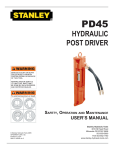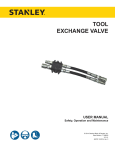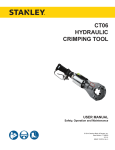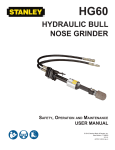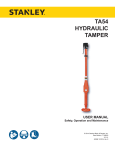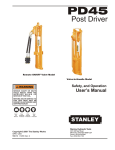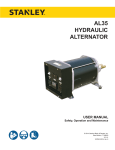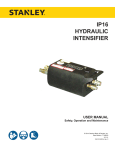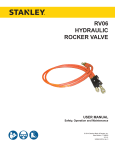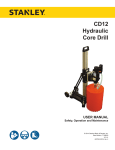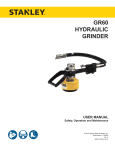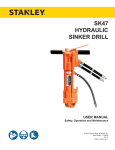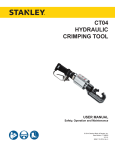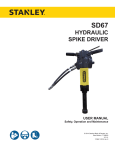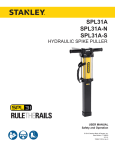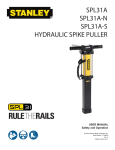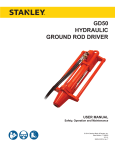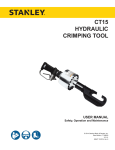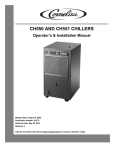Download PD45 User Manual - Stanley Hydraulic Tools
Transcript
PD45 Hydraulic Post Driver USER MANUAL Safety, Operation and Maintenance © 2014 Stanley Black & Decker, Inc. New Britain, CT 06053 U.S.A. 17472 8/2014 Ver. 9 TABLE OF CONTENTS SAFETY SYMBOLS...................................................................................................................................................4 SAFETY PRECAUTIONS...........................................................................................................................................5 TOOL STICKERS & TAGS.........................................................................................................................................6 HOSE TYPES.............................................................................................................................................................7 HOSE RECOMMENDATIONS...................................................................................................................................8 FIGURE 1. TYPICAL HOSE CONNECTIONS........................................................................................................8 HTMA REQUIREMENTS............................................................................................................................................9 OPERATION.............................................................................................................................................................10 CHARGING THE ACCUMULATOR.......................................................................................................................... 11 FIGURE 2. CHARGING THE ACCUMULATOR.................................................................................................... 11 TOOL PROTECTION & CARE.................................................................................................................................12 TROUBLESHOOTING.............................................................................................................................................13 SPECIFICATIONS....................................................................................................................................................14 ACCESSORIES.......................................................................................................................................................14 SERVICE TOOLS.....................................................................................................................................................14 PD45131 PARTS ILLUSTRATION...........................................................................................................................15 PD45131 PARTS LIST.............................................................................................................................................16 PD45132 PARTS ILLUSTRATION...........................................................................................................................17 PD45132 PARTS LIST.............................................................................................................................................18 IMPORTANT To fill out a Product Warranty Validation form, and for information on your warranty, visit Stanleyhydraulics.com and select the Company tab, Warranty. (NOTE: The warranty Validation record must be submitted to validate the warranty). SERVICING: This manual contains safety, operation, and routine maintenance instructions. Stanley Hydraulic Tools recommends that servicing of hydraulic tools, other than routine maintenance, must be performed by an authorized and certified dealer. Please read the following warning. WARNING SERIOUS INJURY OR DEATH COULD RESULT FROM THE IMPROPER REPAIR OR SERVICE OF THIS TOOL. REPAIRS AND / OR SERVICE TO THIS TOOL MUST ONLY BE DONE BY AN AUTHORIZED AND CERTIFIED DEALER. For the nearest authorized and certified dealer, call Stanley Hydraulic Tools at the number listed on the back of this manual and ask for a Customer Service Representative. PD45 User Manual ◄ 3 SAFETY SYMBOLS Safety symbols and signal words, as shown below, are used to emphasize all operator, maintenance and repair actions which, if not strictly followed, could result in a life-threatening situation, bodily injury or damage to equipment. This is the safety alert symbol. It is used to alert you to potential personal injury hazards. Obey all safety messages that follow this symbol to avoid possible injury or death. DANGER This safety alert and signal word indicate an imminently hazardous situation which, if not avoided, will result in death or serious injury. WARNING This safety alert and signal word indicate a potentially hazardous situation which, if not avoided, could result in death or serious injury. CAUTION This safety alert and signal word indicate a potentially hazardous situation which, if not avoided, could result in death or serious injury. CAUTION This signal word indicates a potentially hazardous situation which, if not avoided, may result in property damage. NOTICE This signal word indicates a situation which, if not avoided, will result in damage to the equipment. IMPORTANT This signal word indicates a situation which, if not avoided, may result in damage to the equipment. Always observe safety symbols. They are included for your safety and for the protection of the tool. LOCAL SAFETY REGULATIONS Enter any local safety regulations here. Keep these instructions in an area accessible to the operator and maintenance personnel. 4 ► PD45 User Manual SAFETY PRECAUTIONS Tool operators and maintenance personnel must always comply with the safety precautions given in this manual and on the stickers and tags attached to the tool and hose. These safety precautions are given for your safety. Review them carefully before operating the tool and before performing general maintenance or repairs. Supervising personnel should develop additional precautions relating to the specific work area and local safety regulations. If so, place the added precautions in the space provided in this manual. The PD45 Hydraulic Post Driver will provide safe and dependable service if operated in accordance with the instructions given in this manual. Read and understand this manual and any stickers and tags attached to the tool and hoses before operation. Failure to do so could result in personal injury or equipment damage. • Operator must start in a work area without bystanders. The operator must be familiar with all prohibited work areas such as excessive slopes and dangerous terrain conditions. • Establish a training program for all operators to ensure safe operations. • Do not operate the tool unless thoroughly trained or under the supervision of an instructor. • Always wear safety equipment such as goggles, head protection, and safety shoes at all times when operating the tool. • Do not inspect or clean the tool while the hydraulic power source is connected. Accidental engagement of the tool can cause serious injury. • Do not operate this tool without first reading the Operation section of this manual. • Do not install or remove this tool while the hydraulic power source is connected. Accidental engagement of the tool can cause serious injury. • Never operate the tool if you cannot be sure that underground utilities are not present. Underground electrical utilities present an electrocution hazard. Underground gas utilities present an explosion hazard. Other underground utilities may present other hazards. • Do not wear loose fitting clothing when operating the tool. Loose fitting clothing can get entangled with the tool and cause serious injury. • Supply hoses must have a minimum working pressure rating of 2500 psi/175 bar. • Be sure all hose connections are tight. • The hydraulic circuit control valve must be in the OFF position when coupling or uncoupling the tool. Wipe all couplers clean before connecting. Failure to do so may result in damage to the quick couplers and cause overheating. Use only lint-free cloths. • Do not operate the tool at oil temperatures above 140 °F/60 °C. Operation at higher oil temperatures can cause operator discomfort and may cause damage to the tool. • Do not operate a damaged, improperly adjusted, or incompletely assembled tool. • To avoid personal injury or equipment damage, all tool repair, maintenance and service must only be performed by authorized and properly trained personnel. • Do not exceed the rated limits of the tool or use the tool for applications beyond its design capacity. • Always keep critical tool markings, such as labels and warning stickers legible. • Always replace parts with replacement parts recommended by Stanley Hydraulic Tools. • Check fastener tightness often and before each use daily. • Warning: Use of this tool on certain materials during demolition could generate dust potentially containing a variety of hazardous substances such as asbestos, silica or lead. Inhalation of dust containing these or other hazardous substances could result in serious injury, cancer or death. Protect yourself and those around you. Research and understand the materials you are cutting. Follow correct safety procedures and comply with all applicable national, state or provisional health and safety regulations relating to them, including, if appropriate arranging for the safe disposal of the materials by a qualified person. PD45 User Manual ◄ 5 TOOL STICKERS & TAGS 19693 Danger Sticker 15197 PD45 Name Tag NOTE: THE INFORMATION LISTED ON THE STICKERS SHOWN, MUST BE LEGIBLE AT ALL TIMES. REPLACE DECALS IF THEY BECOME WORN OR DAMAGED. REPLACEMENTS ARE AVAILABLE FROM YOUR LOCAL STANLEY DISTRIBUTOR. The safety tag (P/N 15875) at right is attached to the tool when shipped from the factory. Read and understand the safety instructions listed on this tag before removal. We suggest you retain this tag and attach it to the tool when not in use. D A N G E R 1. FAILURE TO USE HYDRAULIC HOSE LABELED AND CERTIFIED AS NON-CONDUCTIVE WHEN USING HYDRAULIC TOOLS ON OR NEAR ELECTRICAL LINES MAY RESULT IN DEATH OR SERIOUS INJURY. BEFORE USING HOSE LABELED AND CERTIFIED AS NONCONDUCTIVE ON OR NEAR ELECTRIC LINES BE SURE THE HOSE IS MAINTAINED AS NON-CONDUCTIVE. THE HOSE SHOULD BE REGULARLY TESTED FOR ELECTRIC CURRENT LEAKAGE IN ACCORDANCE WITH YOUR SAFETY DEPARTMENT INSTRUCTIONS. 2. A HYDRAULIC LEAK OR BURST MAY CAUSE OIL INJECTION INTO THE BODY OR CAUSE OTHER SEVERE PERSONAL INJURY. A. DO NOT EXCEED SPECIFIED FLOW AND PRESSURE FOR THIS TOOL. EXCESS FLOW OR PRESSURE MAY CAUSE A LEAK OR BURST. B. DO NOT EXCEED RATED WORKING PRESSURE OF HYDRAULIC HOSE USED WITH THIS TOOL. EXCESS PRESSURE MAY CAUSE A LEAK OR BURST. C. CHECK TOOL HOSE COUPLERS AND CONNECTORS DAILY FOR LEAKS. DO NOT FEEL FOR LEAKS WITH YOUR HANDS. CONTACT WITH A LEAK MAY RESULT IN SEVERE PERSONAL INJURY. D A N G E R D. DO NOT LIFT OR CARRY TOOL BY THE HOSES. DO NOT ABUSE HOSE. DO NOT USE KINKED, TORN OR DAMAGED HOSE. 3. MAKE SURE HYDRAULIC HOSES ARE PROPERLY CONNECTED TO THE TOOL BEFORE PRESSURING SYSTEM. SYSTEM PRESSURE HOSE MUST ALWAYS BE CONNECTED TO TOOL “IN” PORT. SYSTEM RETURN HOSE MUST ALWAYS BE CONNECTED TO TOOL “OUT” PORT. REVERSING CONNECTIONS MAY CAUSE REVERSE TOOL OPERATION WHICH CAN RESULT IN SEVERE PERSONAL INJURY. 4. DO NOT CONNECT OPEN-CENTER TOOLS TO CLOSEDCENTER HYDRAULIC SYSTEMS. THIS MAY RESULT IN LOSS OF OTHER HYDRAULIC FUNCTIONS POWERED BY THE SAME SYSTEM AND/OR SEVERE PERSONAL INJURY. 5. BYSTANDERS MAY BE INJURED IN YOUR WORK AREA. KEEP BYSTANDERS CLEAR OF YOUR WORK AREA. 6. WEAR HEARING, EYE, FOOT, HAND AND HEAD PROTECTION. 7. TO AVOID PERSONAL INJURY OR EQUIPMENT DAMAGE, ALL TOOL REPAIR MAINTENANCE AND SERVICE MUST ONLY BE PERFORMED BY AUTHORIZED AND PROPERLY TRAINED PERSONNEL. I M P O R T A N T I M P O R T A N T READ OPERATION MANUAL AND SAFETY INSTRUCTIONS FOR THIS TOOL BEFORE USING IT. READ OPERATION MANUAL AND SAFETY INSTRUCTIONS FOR THIS TOOL BEFORE USING IT. USE ONLY PARTS AND REPAIR PROCEDURES APPROVED BY STANLEY AND DESCRIBED IN THE OPERATION MANUAL. USE ONLY PARTS AND REPAIR PROCEDURES APPROVED BY STANLEY AND DESCRIBED IN THE OPERATION MANUAL. TAG TO BE REMOVED ONLY BY TOOL OPERATOR. TAG TO BE REMOVED ONLY BY TOOL OPERATOR. SEE OTHER SIDE SEE OTHER SIDE SAFETY TAG P/N 15875 (Shown smaller then actual size) 6 ► PD45 User Manual HOSE TYPES The rated working pressure of the hydraulic hose must be equal to or higher than the relief valve setting on the hydraulic system. There are three types of hydraulic hose that meet this requirement and are authorized for use with Stanley Hydraulic Tools. They are: Certified non-conductive — constructed of thermoplastic or synthetic rubber inner tube, synthetic fiber braid reinforcement, and weather resistant thermoplastic or synthetic rubber cover. Hose labeled certified nonconductive is the only hose authorized for use near electrical conductors. Wire-braided (conductive) — constructed of synthetic rubber inner tube, single or double wire braid reinforcement, and weather resistant synthetic rubber cover. This hose is conductive and must never be used near electrical conductors. Fabric-braided (not certified or labeled non-conductive) — constructed of thermoplastic or synthetic rubber inner tube, synthetic fiber braid reinforcement, and weather resistant thermoplastic or synthetic rubber cover. This hose is not certified non-conductive and must never be used near electrical conductors. HOSE SAFETY TAGS To help ensure your safety, the following DANGER tags are attached to all hose purchased from Stanley Hydraulic Tools. DO NOT REMOVE THESE TAGS. If the information on a tag is illegible because of wear or damage, replace the tag immediately. A new tag may be obtained from your Stanley Distributor. D A N G E R D A N G E R 1. FAILURE TO USE HYDRAULIC HOSE LABELED AND CERTIFIED AS NON-CONDUCTIVE WHEN USING HYDRAULIC TOOLS ON OR NEAR ELECTRIC LINES MAY RESULT IN DEATH OR SERIOUS INJURY. FOR PROPER AND SAFE OPERATION MAKE SURE THAT YOU HAVE BEEN PROPERLY TRAINED IN CORRECT PROCEDURES REQUIRED FOR WORK ON OR AROUND ELECTRIC LINES. 2. BEFORE USING HYDRAULIC HOSE LABELED AND CERTIFIED AS NON-CONDUCTIVE ON OR NEAR ELECTRIC LINES. WIPE THE ENTIRE LENGTH OF THE HOSE AND FITTING WITH A CLEAN DRY ABSORBENT CLOTH TO REMOVE DIRT AND MOISTURE AND TEST HOSE FOR MAXIMUM ALLOWABLE CURRENT LEAKAGE IN ACCORDANCE WITH SAFETY DEPARTMENT INSTRUCTIONS. 3. DO NOT EXCEED HOSE WORKING PRESSURE OR ABUSE HOSE. IMPROPER USE OR HANDLING OF HOSE COULD RESULT IN BURST OR OTHER HOSE FAILURE. KEEP HOSE AS FAR AWAY AS POSSIBLE FROM BODY AND DO NOT PERMIT DIRECT CONTACT DURING USE. CONTACT AT THE BURST CAN CAUSE BODILY INJECTION AND SEVERE PERSONAL INJURY. 4. HANDLE AND ROUTE HOSE CAREFULLY TO AVOID KINKING, ABRASION, CUTTING, OR CONTACT WITH HIGH TEMPERATURE SURFACES. DO NOT USE IF KINKED. DO NOT USE HOSE TO PULL OR LIFT TOOLS, POWER UNITS, ETC. 5. CHECK ENTIRE HOSE FOR CUTS CRACKS LEAKS ABRASIONS, BULGES, OR DAMAGE TO COUPLINGS IF ANY OF THESE CONDITIONS EXIST, REPLACE THE HOSE IMMEDIATELY. NEVER USE TAPE OR ANY DEVICE TO ATTEMPT TO MEND THE HOSE. 6. AFTER EACH USE STORE IN A CLEAN DRY AREA. SEE OTHER SIDE SIDE 1 SEE OTHER SIDE (Shown smaller than actual size) DO NOT REMOVE THIS TAG DO NOT REMOVE THIS TAG THE TAG SHOWN BELOW IS ATTACHED TO “CERTIFIED NON-CONDUCTIVE” HOSE SIDE 2 D A N G E R D A N G E R 1. DO NOT USE THIS HYDRAULIC HOSE ON OR NEAR ELECTRIC LINES. THIS HOSE IS NOT LABELED OR CERTIFIED AS NON-CONDUCTIVE. USING THIS HOSE ON OR NEAR ELECTRICAL LINES MAY RESULT IN DEATH OR SERIOUS INJURY. 5. CHECK ENTIRE HOSE FOR CUTS CRACKS LEAKS ABRASIONS, BULGES, OR DAMAGE TO COUPLINGS IF ANY OF THESE CONDITIONS EXIST, REPLACE THE HOSE IMMEDIATELY. NEVER USE TAPE OR ANY DEVICE TO ATTEMPT TO MEND THE HOSE. 2. FOR PROPER AND SAFE OPERATION MAKE SURE THAT YOU HAVE BEEN PROPERLY TRAINED IN CORRECT PROCEDURES REQUIRED FOR WORK ON OR AROUND ELECTRIC LINES. 6. AFTER EACH USE STORE IN A CLEAN DRY AREA. 3. DO NOT EXCEED HOSE WORKING PRESSURE OR ABUSE HOSE. IMPROPER USE OR HANDLING OF HOSE COULD RESULT IN BURST OR OTHER HOSE FAILURE. KEEP HOSE AS FAR AWAY AS POSSIBLE FROM BODY AND DO NOT PERMIT DIRECT CONTACT DURING USE. CONTACT AT THE BURST CAN CAUSE BODILY INJECTION AND SEVERE PERSONAL INJURY. 4. HANDLE AND ROUTE HOSE CAREFULLY TO AVOID KINKING, CUTTING, OR CONTACT WITH HIGH TEMPERATURE SURFACES. DO NOT USE IF KINKED. DO NOT USE HOSE TO PULL OR LIFT TOOLS, POWER UNITS, ETC. DO NOT REMOVE THIS TAG DO NOT REMOVE THIS TAG THE TAG SHOWN BELOW IS ATTACHED TO “CONDUCTIVE” HOSE. SEE OTHER SIDE SEE OTHER SIDE SIDE 1 SIDE 2 (Shown smaller than actual size) PD45 User Manual ◄ 7 8 ► PD45 User Manual All hydraulic hose must meet or exceed specifications as set forth by SAE J517. All hydraulic hose must have at least a rated minimum working pressure equal to the maximum hydraulic system relief valve setting. This chart is intended to be used for hydraulic tool applications only based on Stanley Hydraulic Tools tool operating requirements and should not be used for any other applications. The chart to the right shows recommended minimum hose diameters for various hose lengths based on gallons per minute (gpm)/ liters per minute (lpm). These recommendations are intended to keep return line pressure (back pressure) to a minimum acceptable level to ensure maximum tool performance. Tool to Hydraulic Circuit Hose Recommendations 15-34 MM Inside Diameter INCH USE (Press/Return) PSI up to 10 up to 3 3/8 10 Both 2250 49-60 13-16 FLOW >>> RETURN <<< FLOW PRESSURE 26-100 up to 25 100-200 51-100 up to 50 100-300 51-100 up to 50 26-100 up to 25 8-30 up to 8 30-60 15-30 up to 15 30-90 15-30 up to 15 7.5-30 up to 7.5 Figure 1. Typical Hose Connections 49-60 38-49 10-13 13-16 19-40 5-10.5 38-49 19-40 5-10.5 10-13 19-40 5-10.5 38-49 15-23 10-13 15-23 4-6 19 25.4 16 19 19 25.4 5/8 3/4 3/4 1 19 3/4 1 16 3/4 16 19 3/4 5/8 16 5/8 5/8 16 13 13 10 5/8 1/2 1/2 3/8 Return Pressure Return Pressure Return Pressure Return Pressure Both Return Pressure Both Both Both Both 2500 2500 2500 2500 2500 2500 2500 2500 2500 2500 2500 2500 2500 2500 2500 175 175 175 175 175 175 175 175 175 175 175 175 175 175 175 155 BAR Min. Working Pressure Certified Non-Conductive Hose - Fiber Braid - for Utility Bucket Trucks METERS Hose Lengths FEET Conductive Hose - Wire Braid or Fiber Braid -DO NOT USE NEAR ELECTRICAL CONDUCTORS 4-6 4-9 LPM Oil Flow GPM HOSE RECOMMENDATIONS HTMA / EHTMA REQUIREMENTS HTMA / EHTMA REQUIREMENTS HTMA HYDRAULIC SYSTEM REQUIREMENTS TYPE I Nominal Operating Pressure (at the power supply outlet) 4-6 gpm (15-23 lpm) 1500 psi (103 bar) TOOL TYPE TYPE II TYPE RR 7-9 gpm (26-34 lpm) 1500 psi (103 bar) 9-10.5 gpm (34-40 lpm) 1500 psi (103 bar) System relief valve setting (at the power supply outlet) 2100-2250 psi (145-155 bar) 2100-2250 psi (145-155 bar) 2200-2300 psi (152-159 bar) 2100-2250 psi (145-155 bar) Maximum back pressure (at tool end of the return hose) 250 psi (17 bar) 250 psi (17 bar) 250 psi (17 bar) 250 psi (17 bar) Measured at a max. fluid viscosity of: (at min. operating temperature) 400 ssu* 400 ssu* 400 ssu* 400 ssu* (82 centistokes) (82 centistokes) (82 centistokes) (82 centistokes) Temperature: Sufficient heat rejection capacity to limit max. fluid temperature to: (at max. expected ambient temperature) 140° F (60° C) Flow Range 140° F (60° C) TYPE III 11-13 gpm (42-49 lpm) 1500 psi (103 bar) 140° F (60° C) 140° F (60° C) 3 hp 5 hp 6 hp 7 hp Min. cooling capacity at a temperature (2.24 kW) (3.73 kW) (5.22 kW) (4.47 kW) difference of between ambient and fluid 40° F 40° F 40° F 40° F temps (22° C) (22° C) (22° C) (22° C) NOTE: Do not operate the tool at oil temperatures above 140° F (60° C). Operation at higher temperatures can cause operator discomfort at the tool. Filter Min. full-flow filtration Sized for flow of at least: (For cold temp. startup and max. dirt-holding capacity) 25 microns 30 gpm (114 lpm) Hydraulic fluid Petroleum based (premium grade, anti-wear, non-conductive) Viscosity (at min. and max. operating temps) 100-400 ssu* 25 microns 30 gpm (114 lpm) 25 microns 30 gpm (114 lpm) 25 microns 30 gpm (114 lpm) 100-400 ssu* 100-400 ssu* (20-82 centistokes) 100-400 ssu* NOTE: When choosing hydraulic fluid, the expected oil temperature extremes that will be experienced in service determine the most suitable temperature viscosity characteristics. Hydraulic fluids with a viscosity index over 140 will meet the requirements over a wide range of operating temperatures. *SSU = Saybolt Seconds Universal EHTMA HYDRAULIC SYSTEM REQUIREMENTS CLASSIFICATION B C D Nominal Operating Pressure (at the power supply outlet) 3.5-4.3 gpm (13.5-16.5 lpm) 1870 psi (129 bar) 4.7-5.8 gpm (18-22 lpm) 1500 psi (103 bar) 7.1-8.7 gpm (27-33 lpm) 1500 psi (103 bar) 9.5-11.6 gpm (36-44 lpm) 1500 psi (103 bar) 11.8-14.5 gpm (45-55 lpm) 1500 psi (103 bar) System relief valve setting (at the power supply outlet) 2495 psi (172 bar) 2000 psi (138 bar) 2000 psi (138 bar) 2000 psi (138 bar) 2000 psi (138 bar) Flow Range NOTE: These are general hydraulic system requirements. See tool specification page for tool specific requirements PD45 User Manual ◄ 9 OPERATION PRE-OPERATION PROCEDURES TOOL OPERATION CHECK THE POWER SOURCE 1. Observe all safety precautions. 1. Using a calibrated flowmeter and pressure gauge, check that the hydraulic power source develops a flow of 7–9 gpm/26–34 lpm at 2000 psi/140 bar. 2. Install the appropriate adapter as required. 3. Place the post driver foot firmly on the surface to be driven. 2. Make certain the hydraulic power source is equipped with a relief valve set to open at 2100–2250 psi/140 bar. 4. Press the lever assembly on handle to start the post driver. INSTALLING ADAPTERS 1. The post hammer is designed to drive No. 1 through No. 4 sign post, 2-1/2 inch square and up to 2-5/8 inch diameter round post without requiring adapters. If you are driving one of these types of post, orient the post into the tightest fit in the post driver foot. 2. If you are driving smaller square or round post, insert the adapter to the post driver foot using two ½-hex head capscrews. CONNECTING HOSES 1. Wipe all hose couplers with a clean, lint-free cloth before making connections. 2. Connect the hoses from the hydraulic power source to the tool fittings or quick disconnects. It is a good practice to connect return hoses first and disconnect them last to minimize or avoid trapped pressure within the tool. 3. If hose couplers are used, observe the arrow on the coupler to ensure that the flow is in the proper direction. The female coupler on the tool hose is the inlet (pressure) coupler. 4. Move the hydraulic power source On/Off control valve to the ON position to operate the tool. NOTE: If uncoupled hoses are left in the sun, pressure increase inside the hoses may make them difficult to connect. When possible, connect the free ends of the operating hoses together. 10 ► PD45 User Manual NOTE: On Remote ON/OFF Valve Models Place the post driver on/off control valve in The ON position to start the post driver. NOTE: Adequate down pressure is very important. 5. When the post is fully set in the ground, release the lever assembly on handle. COLD WEATHER OPERATION If the post hammer is to be used during cold weather, preheat the hydraulic fluid at low engine speed. When using the normally recommended fluid, fluid temperature should be at or above 50°F/10°C (400 ssu/82 centistrokes) before use. Damage to the hydraulic system or post driver can result from use with fluid that is too viscous or thick. CHARGING THE ACCUMULATOR ACCUMULATOR TESTING PROCEDURE ACCUMULATOR CHARGING PROCEDURE To check or charge the accumulator the following equipment is required: 1. Perform Steps 1 through 4 of the Accumulator Testing Procedure above. • Accumulator Tester (Part Number 02835). • Charging Kit Assembly (P/N 31254); (includes a regulator, hose and fittings). • NITROGEN bottle with an 800 psi/56 bar minimum charge. 2. Connect the chuck of the charging assembly to the charging valve on the accumulator tester or, if preferred, remove the tester from the tool charging valve and connect the charging assembly chuck directly to the tool charging valve. 1. Remove the charging valve plug from the post driver. 2. Holding the chuck end of Stanley tester (P/N 02835), turn the gauge fully counter-clockwise to ensure the stem inside the chuck is completely retracted. 3. Thread the tester onto the charging valve of the tool accumulator (do not advance the gauge-end into the chuck end; turn as a unit). Seat the chuck on the accumulator charging valve and hand tighten only. 4. Advance the valve stem by turning the gauge-end clockwise until pressure is read on the gauge (charging pressure should be 500–700 psi/34–38 bar). 5. If pressure is OK unscrew the gauge-end from the chuck to retract the stem, then unscrew the entire tester assembly from the tool accumulator charging valve. If pressure is low, charge the accumulator as described in the following section. 3. Adjust the regulator to the charging pressure of 600 psi/42 bar. NOTE: It may be necessary to set the regulator at 650– 700 psi/45–48 bar to overcome any pressure drop through the charging system. 4. Open the valve on the charging assembly hose. 5. When the accumulator is fully charged close the valve on the charging assembly hose and remove the charging assembly chuck from the accumulator tester of tool charging valve. 6. If the accumulator tester has been used, be sure to turn the gauge-end fully counterclockwise before removing the tester from the charging valve of the tool. 7. Replace the O-ring plug. 6. Install the charging valve cap (or plug). Guage Chuck Tester Charging Valve Accumulator Tester (P/N 02835) Location Of Charging Valve Figure 2. Charging the Accumulator PD45 User Manual ◄ 11 TOOL PROTECTION & CARE NOTICE In addition to the Safety Precautions found in this manual, observe the following for equipment protection and care. • Make sure all couplers are wiped clean before connection. • Always keep critical tool markings, such as warning stickers and tags legible. • The hydraulic circuit control valve must be in the OFF position when coupling or uncoupling hydraulic tools. Failure to do so may result in damage to the quick couplers and cause overheating of the hydraulic system. • Do not use the tool for applications it was not designed for. • Tool repair should be performed by experienced personnel only. • Make certain that the recommended relief valves are installed in the pressure side of the system. • Do not use the tool for applications for which it was not intended. • Always store the tool in a clean dry space, safe from damage or pilferage. • Make sure the circuit PRESSURE hose (with male quick disconnect) is connected to the IN port. The circuit RETURN hose (with female quick disconnect) is connected to the opposite port. Do not reverse circuit flow. This can cause damage to internal seals. • Always replace hoses, couplings and other parts with replacement parts recommended by Stanley Hydraulic Tools. Supply hoses must have a minimum working pressure rating of 2500 psi/172 bar. • Do not exceed the rated flow (see Specifications) in this manual for correct flow rate and model number. Rapid failure of the internal seals may result. 12 ► PD45 User Manual TROUBLESHOOTING If symptoms of poor performance develop, the following chart can be used as a guide to correct the problem. When diagnosing faults in operation of the tool, always make sure the hydraulic power source is supplying the correct hydraulic flow and pressure as listed in the table. Use a flowmeter know to be accurate. Check the flow with the hydraulic fluid temperature at least 80 °F/27 °C. PROBLEM Tool does not run. Tool does not hit effectively. Tool operates slowly. Tool gets hot. CAUSE SOLUTION Power unit not functioning. Check power source for proper flow and pressure (7–9 gpm/26–34 lpm, 2000 psi/140 bar). Couplers or hoses blocked. Remove restriction. Pressure and return line hoses reversed at ports. Be sure hoses are connected to their proper ports. Mechanical failure of piston or automatic valve. Disassemble post driver and inspect for damaged parts. Low accumulator charge (pressure hose will pulse more than normal). Recharge accumulator. Replace diaphragm if charge loss continues Power unit not functioning. Check power unit for proper flow and pressure (7–9 gpm/26–34 lpm, 2000 psi/140 bar). Couplers or hoses blocked. Remove restriction. Fluid too hot (above 140 °F/60 °C). Provide cooler to maintain proper oil temperature (130 °F/55 °C maximum). The anvil is not sliding freely in the post driver foot. Remove, clean, lubricate and replace anvil as required. Low gpm supply from power unit. Check power source for proper flow (7–9 gpm/ 26-64 lpm). High back-pressure. Check hydraulic system for excessive backpressure (over 250 psi/17 bar). Couplers or hoses blocked. Remove restriction. Orifice blocked. Remove restriction. Fluid too hot (above 140 °F/60 °C) or too cold (below 60 °F/16 °C). Check power source for proper fluid temperature. Bypass cooler to warm fluid up or provide cooler to maintain proper temperature. Relief valve set too low. Adjust relief valve to 2100–2250 psi/145–155 bar. The anvil is not sliding freely in the post driver foot. Remove, clean, lubricate and replace as required. Hot fluid going through tool. Check power unit. Be sure flow rate is not too high causing part of the fluid to go through the relief valve. Provide cooler to maintain proper fluid temperature (140 °F/60 °C max). Check relief valve setting. Eliminate flow control devices. Oil leakage on post. Lower piston seal failure. Replace seal. PD45 User Manual ◄ 13 SPECIFICATIONS Weight (Standard)..................................................................................................................................65 lbs/29.5 kg Weight (Extended anvil)...........................................................................................................................71 lbs/32 kg. Pressure Range................................................................................................................................ 2000 psi/140 bar Flow Range....................................................................................................................................7-9 gpm/26-34 lmp Optimum Flow........................................................................................................................................ 8 gpm/30 lpm HTMA Class II ............................................................................................................................. 7-9 gpm @ 2000 psi Couplers......................................................................................................................................... HTMA Flush Face Per NFPA T3.20.15/ISO 16028 Connect Size....................................................................................................................................... 3/8 female pipe Length...................................................................................................................................................... 30 in./76 cm Width (Across Handles)................................................................................................................... 10-1/8 in./25.7 cm System Type..............................................................................................................................................open center Port Size..................................................................................................................................................SAE 8 O-ring Hose Whips............................................................................................................................................................ Yes Capacity.......................................................................................................................................... #2, #3 and #4 lb/ft U Channel Sign Post #3 and #4 Strong Back (Heavy Duty) U Channel Sign Post #1 Delineator Post 2-1/2 in./63.5 mm Square Post 2-5/8 in./67 mm Round Post ACCESSORIES (SEE PAGE 18) Adapter, 1-3/4 in. Square Post...........................................................................................................................15184 Adapter, 2 in. Round Pipe..................................................................................................................................15185 Adapter, 2-1/4 in. Square Post...........................................................................................................................15186 Adapter, 2 in. Square Post.................................................................................................................................15187 SERVICE TOOLS Tamper Sleeve Tool............................................................................................................................................ 01120 O-ring Tool Kit.....................................................................................................................................................04337 Flow Sleeve Removal Tube................................................................................................................................04910 Flow Sleeve Removal Tool.................................................................................................................................04919 Accumulator Cylinder Puller...............................................................................................................................05640 14 ► PD45 User Manual PD45131 PARTS ILLUSTRATION PD45 User Manual ◄ 15 PD45131 PARTS LIST ITEM PART NO. QTY DESCRIPTION 1 15190 1 TOP PLATE 2 11588 1 ACCUMULATOR VALVE BLOCK 3 04374 4 LOCK NUT 5/8-18 4 00293 1 O-RING 5 15188 1 VALVE SPOOL 6 07493 1 MALE O-RING PLUG 7 20499 1 CHARGE VALVE 8 07479 1 ACCUMULATOR DIAPHRAGM 9 04381 2 BACK-UP RING 10 04379 2 O-RING 11 04378 1 PORTING BLOCK 12 04571 2 PUSH PIN 13 04382 1 AUTOMATIC VALVE 14 04605 4 PUSH PIN 15 04383 1 FLOW SLEEVE TUBE 16 12139 4 SIDE ROD 17 02022 1 O-RING 18 04386 1 CUP SEAL 19 04780 1 WASHER 20 04387 1 ROD WIPER 21 370351 4 CAPSCREW 22 15191 1 ADAPTER BLOCK 23 15189 1 ANVIL 24 15170 1 POST DRIVER FOOT 25 15182 2 HANDLE BAR 26 15194 2 SET SCREW, 3/8-16 × 1/2 HSH 27 04058 1 SPRING 28 07480 1 AUTOMATIC VALVE BODY 29 07481 1 PISTON 30 07485 1 FLOW SLEEVE 31 12146 1 SPRING 32 12143 1 UPPER ANVIL STOP 33 15183 1 ANVIL BUSHING 34 00856 2 1/2 INCH SAE TO 1/2 INCH TUBE 35 66722 2 HOSE ASSY (PD45131 & PD4513103) 35784 2 HOSE ASSY (PD45131J) 36 — — NO ITEM 37 00026 1 O-RING 38 02900 2 ROLL PIN 39 15197 1 PD45 NAME TAG 40 00936 2 ADAPTER 41 19693 1 DANGER STICKER 42 13568 2 BACK UP RING (OLD INLINE VALVE) 07224 2 BACK UP RING (NEW INLINE VALVE) 13567 2 O-RING (OLD INLINE VALVE) 43 16 ► PD45 User Manual PART NO. QTY DESCRIPTION 07626 2 O-RING (NEW INLINE VALVE) 01003 2 ON-OFF VALVE BUTTON (OLD INLINE VALVE) 56749 2 SEAL CAP (NEW INLINE VALVE) 45 10536 1 SELECTOR SCREW 46 03972 1 FEMALE COUPLER 3/8 NPT 47 03973 1 MALE COUPLER 3/8 NPT 48 16070 1 RETAINING RING 49 38631 1 VALVE SPOOL (OLD INLINE VALVE) 67008 1 VALVE SPOOL (NEW INLINE VALVE) 38629 1 VALVE BODY ASSY (OLD INLINE VALVE) 67007 1 VALVE BODY ASSY (NEW INLINE VALVE) 51 11499 2 ADAPTOR 1/2 INCH SAE–3/8 NPTF 52 56747 2 SEAL WIPER 53 01604 2 O-RING ITEM 44 50 04595 SEAL KIT For Post Adaptors (See Page 18). Read Before Ordering Inline Valve Parts: Inline Valve Assembly (OC-CC) - 72264 Includes Items (37, 42 thur 45, thru 50, 52, and 53) The inline valve changed around June 2011. To determine if you have the old or new inline valve, see parts illustration. NOTE: Individual parts are still available for the older inline valve but if replacing the entire inline valve assy, you must order the new inline valve assy P/N72264. PD45132 PARTS ILLUSTRATION PD45 User Manual ◄ 17 PD45132 PARTS LIST ITEM PART NO. QTY DESCRIPTION ITEM PART NO. QTY DESCRIPTION 1 07493 1 O-RING PLUG–MALE 46 00038 1 NUT 1/4-20 PLAIN 2 20499 1 CHARGE VALVE 47 20399 1 OVAL PT SET SCREW 1/4 3 20387 1 PLUNGER 48 12143 1 UPPER ANVIL STOP 4 12100 4 STEEL BALL 3/8 DIA. 49 15183 1 ANVIL BUSHING 5 00899 2 HHCS 1/4-20 UNC × 1/2 GR5 50 12146 1 SPRING 6 20386 1 COVER PLATE 51 15189 1 ANVIL 7 04374 4 LOCK NUT 5/8-18 52 15182 2 HANDLE BAR 8 20390 1 LIFT STRAP 53 15194 2 SET SCREW 9 20384 1 SPACER 54 15170 1 POST DRIVER FOOT 10 370351 4 HHCS 5/8-11 UNC × 1-3/4 55 20388 1 VALVE ACTUATOR HOUSING 11 20385 1 PILOT RING 56 15197 1 PD45 NAME TAG 12 02003 1 O-RING 57 03973 1 MALE COUPLER 13 20398 1 SUPPORT WASHER 3/4 58 03972 1 FEMALE COUPLER 14 08016 1 RETAINING RING 3/4 EXT 15 12139 2 SIDE ROD 04595 1 SEAL KIT 16 08087 2 SIDE ROD 17 00293 1 O-RING 18 04056 1 ROD WIPER 5/16 × 9/16 19 01362 1 O-RING 20 04057 1 BUSHING 21 04077 1 VALVE SPOOL OC 22 04058 1 SPRING 23 07479 1 ACCUMULATOR DIAPHRAGM 24 — — NO ITEM ADAPTORS: 25 09546 2 PIGTAIL HOSE ASSY–18 IN. OAL 2” Round Post P/N-15185 26 — — NO ITEM 27 04381 2 BACK-UP RING 1-3/4” SQ Post P/N- 15184 28 04379 2 O-RING 29 04378 1 PORTING BLOCK 2-1/4” SQ Post P/N- 15186 30 07481 1 PISTON 1-3/4” Round 31 15191 1 ADAPTOR BLOCK 32 04387 1 ROD WIPER 33 04780 1 BACK-UP WASHER 34 04386 1 CUP SEAL 35 02022 1 O-RING 36 04383 1 FLOW SLEEVE TUBE 37 07485 1 FLOW SLEEVE 38 04605 4 PUSH PIN 39 02900 2 ROLL PIN 40 04382 1 AUTOMATIC VALVE 41 04571 2 PUSH PIN 42 07480 1 AUTOMATIC VALVE BODY 43 11588 1 ACCUMULATOR VALVE BLOCK 44 20396 1 VALVE TOP PLATE 45 20392 1 TRIGGER ASSY 18 ► PD45 User Manual 2” SQ Post P/N- 15187 P/N- 67784 1/2-13 UNC x 1.250” Hex Head Capscrew (GR-5 Minimum) P/N- 04661 Clean ID/OD of threads, apply 242 Loctite or equivalent, torque to 50 ft-lb. Stanley Hydraulic Tools 3810 SE Naef Road Milwaukie, Oregon 97267-5698 USA (503) 659-5660 / Fax (503) 652-1780 www.stanleyhydraulics.com




















